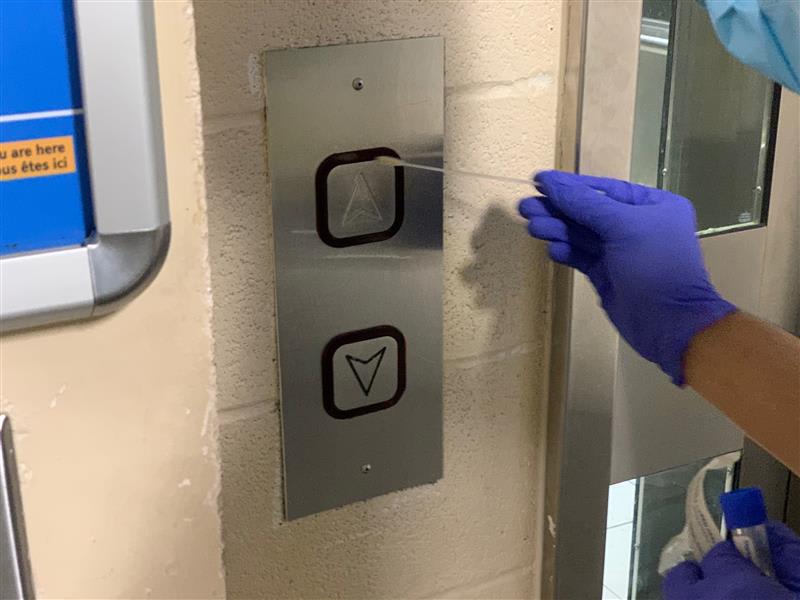Metrolinx does air & surface sampling project to detect virus
Metrolinx turns to science to further enhance its safety measures to fight back against COVID-19.
Sep 23, 2021
As Metrolinx marks Rail Safety Week, an international campaign to bring awareness and caution around railways, some dangers loom large – from fast moving trains to pedestrians who aren’t paying enough attention on platforms.
But there are also, in these days of COVID-19, much smaller threats.
Hygiene Officer Brandon Nguyen tests elevator buttons. (Romain Mathevet photo)
An elevator is tested inside Union Station. (Romain Mathevet photo)
The Metrolinx Incident Command team is continually exploring new and novel methods of enhancing the response to the COVID-19 pandemic – ensuring customers and transit employees are safe at work. During Rail Safety Week, Metrolinx will be conducting a pilot study of environmental sampling, looking for the SARS-CoV-2 virus in air and on surfaces.
A collection of a surface sample for the SARS-CoV-2 virus from a push bar door in the York Concourse by Hygiene Officer Romain Mathevet. ( Brandon Nguyen photo)
SARS-CoV-2 is simply the virus that causes COVID-19 and is a member of a much larger family of viruses called ‘coronaviruses’.
Public health agencies have reported the primary mode of transmission for COVID-19 is through respiratory droplets or aerosols from an infectious person. Aerosols may linger in the air for a period of time or settle on surfaces. Although less common, touching a surface contaminated with the virus is also a potential path of transmission.
A device takes air samples inside Union Station. (Romain Mathevet photo)
To assess the effectiveness of Metrolinx’s COVID-19 control measures, environmental sampling will consist of collecting air and surface swab samples from high traffic / high touch surfaces inside Union Station, Union Station Bus Terminal, buses, and trains. After collection, the air and swab samples will be sealed and placed in a hard-sided cooler – kept at 2ºC to 8ºC. They will then be sent to an accredited laboratory and analyzed.
This image shows the filter cassette that will be used for air sampling. It consists of a sterile, endotoxin-free, polycarbonate filter in a PVC housing through which air (and any suspended particle or droplets) is pumped. (Metrolinx photo)
While each of the samples won’t provide an indication of infectiousness – answering the question, could you catch COVID-19 through it? – they should provide evidence if the genetic material of the virus was detected.
Final results of the sampling campaign will be made available through Metrolinx News in the weeks ahead.
Most environmental samples are collected as part of research studies in hospital or health care settings. But other transit agencies are also looking at how testing can be used to help protect riders and workers. Transport for London in the UK performed regular environmental sampling on its network late last year and did not detect any SARS-CoV-2 material in any of the locations. This year, Network Rail in the UK also performed air and surface sampling for the virus at four of its transit stations and found only negative results as well.
As always, Metrolinx will continue to take public safety seriously through the pandemic. Environmental sampling for the SARS-CoV-2 virus is just one more item on a list of more than 40 measures Metrolinx has instituted since the start of the COVID-19 pandemic.
Because while Rail Safety Week is spending a great deal of time to remind people of big reasons to be aware around transit tracks and locations, the world has learned that small threats can also have major impacts.
Want to know more about Operation Lifesaver, a volunteer organization of experts who are partnering with Metrolinx to get the word out on Rail Safety Week? Then just go here.
And if you’re looking for detailed work on the ‘Stop Track Tragedies’ campaign, which is at the heart of this year’s Rail Safety Week attention, then click here.
by Chris Fraser Metrolinx senior manager for Occupational Health, Safety and Environment
